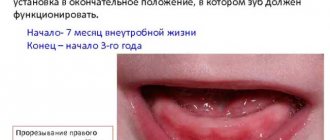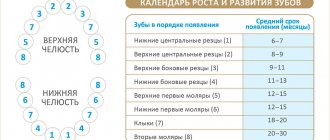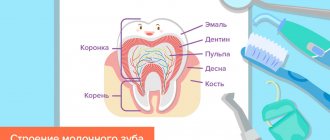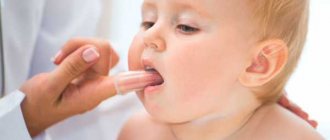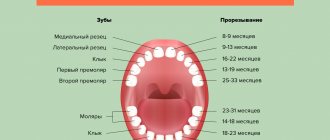The appearance of an infant’s first milk teeth is a difficult period for both him and his parents. The baby often cries, is capricious and demands increased attention from mom and dad. Teething is often accompanied by an increase in temperature. It lasts for 1-3 days, after which the child’s condition stabilizes.
Teething can be called a purely individual process. In some children it is completely asymptomatic, while in others very unpleasant symptoms appear that significantly worsen the baby’s life - diarrhea, hyperthermia, loss of appetite, inflammation of the gums and others. This clinical picture often confuses parents - they cannot understand whether these signs are related to teething or whether the child is developing some kind of pathology.
Parents' biggest concern during teething is temperature. It can rise to dangerous levels - 39-40°C. To alleviate the child’s condition, it is necessary to be able to provide him with first aid, as well as to recognize in time the signs indicating that you urgently need to either call an ambulance or go to the hospital yourself.
Why does the temperature rise
Teething is a traumatic process. Dental units damage the gum mucosa and inflammation occurs, which in medicine is called aseptic (microbial-free). This process is accompanied by an increase in temperature. In addition, during teething, some processes occur in the baby’s body that stimulate hyperthermia:
- at the site of localization of future milk teeth, specific substances necessary for softening the bone tissue of the jaw begin to be actively produced;
- Since all the forces of the child’s body are aimed at teething as quickly as possible, the immune system weakens a little. During this period, infectious agents present in the body may become active and diseases will begin to progress. Many of them are accompanied by an increase in temperature.
Damaged gums are the “entry gate” for infection. Through them, pathogenic microflora can penetrate the body and provoke the development of a septic inflammatory process. The body also responds to such an attack with an increase in temperature. To prevent infection, it is recommended to take more careful care of your baby’s gums during this difficult period for him. Pharmaceutical companies now produce many drugs that have a triple effect - relieve pain, reduce inflammation, fight viruses, bacteria and fungi. But before using these medications, it is recommended to consult your pediatrician.
Teething symptoms
A child's first teeth begin to erupt between 4 and 8 months. There are exceptions. Sometimes children are born with several teeth, while others show them only after a year. Teething is a difficult process for a child. It can be accompanied by various symptoms, but the most common are the following:
- How long does it take for drugs to leave the body?
- Increased nervousness. The child cries for no reason, whines. Teething may be accompanied by painful sensations that prevent him from sleeping normally. As a result, the regime of wakefulness and rest is disrupted.
- Heavy salivation. This is a protective process. Saliva has anti-inflammatory and bactericidal properties. Hypersalivation helps protect inflamed gums from infection. Sometimes there is so much saliva that it flows down the chin onto the neck and chest. You should not constantly rub your baby's delicate skin. It is permissible to periodically carefully blot with dry wipes.
- Loose stools. During teething, the baby may experience diarrhea. It is caused by increased salivation, changes in intestinal microflora, or increased bacterial activity due to a decrease in the body's immune defense.
- Decreased appetite. Often, due to pain in the gums, infants refuse to eat. In this case, it is a little easier for those who are breastfed, since the sucking process calms and pacifies the baby.
- Inflammation of the gums. This is the natural state of affairs at the time of teething. If a white stripe appears in some place of the gum, the tooth will soon come out.
- Runny nose. Sometimes swelling and inflammation from the gums spreads to the nasal mucosa. As a result, the baby begins to snot.
- Itching in the gums. The baby puts all the objects that come to hand into his mouth. This is how he scratches his gums. To make his task easier, you can purchase special teething toys in stores.
- Hyperthermia. The temperature rises in 80% of cases. It is important to ensure that it does not reach critical levels. Once every 1-2 hours, it is recommended to measure it not with an electronic, but with a mercury thermometer, since it is more reliable.
All these symptoms frighten parents, as they are similar to the signs of many other diseases of the upper respiratory tract and gastrointestinal tract. These symptoms are typical for teething. But you need to monitor the baby’s condition very carefully, and if the clinic is accompanied by other alarming symptoms, you need to immediately contact your doctor.
Causes of diarrhea in an infant
Teeth coming through can cause diarrhea.
There are cases when you can independently rid a child of an illness such as diarrhea, but some situations require medical intervention. Below are the main causes of diarrhea in infants:
- Nutrition for a nursing mother. It happens that after using some new product, a mother notices changes in her child’s stool. Diarrhea can be caused by eating fresh fruit, vegetables, herbs, or too fatty foods. Treatment is limited to correcting the feeding mother’s diet and eliminating the “provocateur product” from the diet.
- Baby food. Cases when a child experiences diarrhea due to dietary habits: an allergic reaction to an adapted formula; start of complementary feeding (4-6 months); consumption of a previously unfamiliar product; untimely introduction of the product (the child’s digestive system is formed gradually, so it is advisable to introduce the products, following the advice of the WHO); insufficient amount of enzymes. This problem can also be solved by adjusting the diet.
- Lactase and gluten deficiency. This problem is a child’s intolerance to cereals and dairy products. Recently, such cases have become more frequent; children do not have enough enzymes necessary to digest this kind of food. If the problem of lactase deficiency arises during breastfeeding, then the mother needs to exclude dairy products from the diet, and if with artificial milk, transfer the baby to low-lactose adapted formulas. If you have gluten deficiency, you need to exclude cereals such as wheat, semolina, barley, as well as bread, buns, cookies and other baked goods from your baby’s diet. Signals for testing for lactase and gluten deficiency (in addition to constant diarrhea) are skin rashes and insufficient weight gain in the baby. The problem of milk intolerance may disappear on its own after the baby is four months old, as his body will be prepared to produce the necessary enzymes required to digest mother's milk.
- Teething. When a baby gets a new tooth, he may experience diarrhea. There is no need to treat it; after the tooth hatches, the problem will disappear. Reasons: excessive secretion of saliva and its entry into the gastrointestinal tract, impaired peristalsis, weak immunity, infection in the intestines, irritated intestinal walls.
- Intestinal infection. This is the most common cause of diarrhea in infants. It is not at all difficult to get an intestinal infection, since the baby puts everything that comes to hand into his mouth, so it is important to monitor the cleanliness of foods and objects that are accessible to his eyes. In a mild form, such an infection is not dangerous and goes away on its own in a short period of time. If everything is much more serious, then you can observe an elevated temperature and severe diarrhea. An intestinal infection can cause acute diseases such as dysentery, amoebiasis, salmonellosis, etc. These diseases lead to fever, vomiting, critical dehydration, and weight loss. If you have such signs, you should immediately consult a doctor. In particularly difficult situations, you will have to go to an infectious diseases hospital.
- Dysbacteriosis. The very concept of dysbiosis does not imply a specific disease; it is a kind of violation of the proportions of beneficial microflora to pathogenic ones. Dysbacteriosis in infants is very common, which is explained by the incompletely formed organs of the digestive system. There is debate about whether it is worth taking measures for a child who is 2-3 months old? Some doctors prescribe taking probiotics, which should restore the balance of the intestinal microflora, while others are convinced that the baby’s gastrointestinal tract is immature for natural reasons, so interfering with the microflora of a child under 12 months is more likely to harm than benefit.
- Congenital intestinal pathologies. This phenomenon is very rare, but it still occurs. Acute surgical pathologies: appendicitis, peritonitis (inflammation of the abdominal cavity), intussusception (gastrointestinal obstruction). Symptoms of acute pathologies: sharp pain in the abdominal area, elevated body temperature, vomiting, bloating. You should not put off visiting an ambulance if your baby has similar symptoms.
Symptoms indicating pathology
An increase in temperature during teething is a natural process. This is a kind of protective reaction of the baby’s body. At this time, it is necessary to carefully assess the general condition of the child. Sometimes dangerous pathologies can be hidden behind teething syndrome. Therefore, parents should know the symptoms indicating the progression of the pathological process:
- Vomit. Single vomiting can occur at high temperatures. But if it recurs, the baby feels very bad and has diarrhea, you need to see a doctor as soon as possible. These are signs of intestinal infection or poisoning.
- Nasal congestion or discharge of thick yellow-green snot. This is not the norm, it is a pathology that requires adequate and immediate treatment.
- Coughing. During teething, a lot of saliva is released. Often children simply do not have time to swallow it, and they may choke. A cough appears reflexively, which is not pathological. But if wheezing is heard and a certain amount of sputum is released during coughing, this indicates the development of diseases of the upper respiratory tract (tracheitis, bronchitis and others).
- Stomach ache. With normal teething, this symptom should be absent. If the baby is restless, capricious, cries, or pulls his legs toward his stomach, these are alarming signs. Especially if the abdominal pain is accompanied by repeated vomiting. This symptom complex indicates the development of an intestinal infection. The child could pick it up through toys and other objects that he pulled into his mouth.
- Red throat. Swelling from the gums does not spread to the palate. It can spread to the nasal cavity. If the throat and palate are hyperemic (reddened) upon examination, this is the first sign of the development of pharyngitis.
If you have at least one of these symptoms, you should immediately contact your doctor or go to a medical facility. There the child will be examined by a pediatrician and prescribed the correct treatment. It is prohibited to give any medications (except antipyretics) at home without prior approval from the doctor.
How and what to feed a baby when teething
The reaction to teeth depends on the individual characteristics of the child, his sensitivity to pain, nutrition and even the climate. Teething is often painful, causing children to refuse to drink or eat for a while. What to feed your baby when teething, as well as what are the first noticeable signs of teething and simple remedies that will help ensure more comfortable feeding and return to normal sleep, we will find out in a conversation with pediatrician Anastasia Anatolyevna Nikulina.
— Anastasia Anatolyevna, when babies start teething, how long does teething last?
— Children can “show off” their first central incisors at about six months. However, the first symptoms of teething in infants may appear a couple of months before the tooth appears. And it is advisable to see the beginning of the process in time to help the baby survive the pain. In most babies, symptoms of discomfort are detected three to four days before teething and usually disappear on the fourth day after the tooth comes out.
Obvious signs of teething in a baby:
- increased salivation, rash on the face and chest from constant wetting;
- swelling of the gums, their increased sensitivity when sucking;
- The toddler is irritable and whiny, capricious, does not accept the breast/bottle;
- the baby gnaws, bites objects, trying to relieve soreness in the mouth;
- The baby's sleep is disturbed and wakefulness appears at night.
— Teething discomfort is often mistaken for a cold or allergy. How to distinguish one condition from another?
— Teeth growth is a physiological stage, and, as a rule, it does not have negative consequences for the child’s health, despite frequent crying, fever, and excessive anxiety. It is possible to differentiate childhood illnesses based on knowledge of their characteristic signs.
Table. How to tell if your baby is teething
| Frequent manifestations | A tooth appears through the gum | The disease develops |
| Cough |
|
|
| Nasal discharge |
A saline solution is recommended for rinsing the spout. |
|
| Increase in body temperature to 38 °C |
|
|
| Rashes |
|
|
| Immunity weakens |
|
| Cough | A tooth appears through the gum
| The disease develops
|
| Nasal discharge | A tooth appears through the gum
A saline solution is recommended for rinsing the spout. | The disease develops
|
| Increase in body temperature to 38 °C | A tooth appears through the gum
| The disease develops
|
| Rashes | A tooth appears through the gum
| The disease develops
|
| Immunity weakens | The disease develops
|
— Parents are often concerned that their children are not eating enough. Are a baby's first teeth and decreased weight gain related?
— Poor appetite is an alarming symptom that occurs against the background of teeth moving and pressure on aching gums during feeding. The baby does not attach well to the breast, pushes out the nipple and receives less nutrition, which leads to a cessation of weight gain. It is better to simply temporarily switch to a free feeding regime, but not to force feed the baby.
Poor appetite in an infant may be accompanied by the following behavioral changes:
- complete or partial refusal of breast/bottle;
- constant whims when feeding with body writhing;
- increased desire to put something in the mouth followed by refusal to eat due to increased discomfort and itching in the gums;
- loss of interest in solid foods, especially in children on a mixed diet.
After the tooth breaks through the gum, the inflammation goes away and the appetite is completely restored. Therefore, you should not worry about your child’s reluctance to eat. The baby can get the required amount of vitamins through breast milk or formula. The main thing is not to skip two meals in a row.
— What if the child often refuses to suck the breast or pacifier?
“Parents need to be patient. An inflammatory process in the mouth - which means nights without sleep and a moody mood - reduces appetite. Any touching of the gums is accompanied by discomfort, so the baby does not want to suck. In such a situation, force feeding is useless. But even if the child misses two or three feedings per day, nothing bad will happen, everything will get better soon. When he gets very hungry, he will still take the breast or bottle and will definitely eat.
— A restless baby is waiting for support - how to soothe itching and inflammation of the gums?
— Teeth do not appear before three months, and sometimes a “dental holiday” in the family is celebrated closer to a year. The parents' task is not to miss the moment the tooth comes out in order to facilitate the process.
Teether-pacifier
- Given with the appearance of the first incisor for scratching the outside of the jaw. The itching subsides as teeth grow along the edges of the mouth. It is better to look for a wide pacifier (it is so convenient to reach hard-to-reach places in the oral cavity) with a narrow handle-limiter (does not interfere with the grip and prevents the pacifier from being swallowed too deeply).
Materials:
|
|
|
Sippy cup
— Teething is accompanied by a strong secretion of saliva, therefore, in order to normalize the water balance, plenty of drinking is often given from a convenient sippy cup. Its spout is made of rubber, and the valve does not allow liquid to leak. In addition, convenient holders prevent the bottle from slipping out of the baby's hands. Children are delighted with this “toy” and drink from a beautiful bottle with great diligence.
Pain reliever, gum gel
- Your doctor will advise you on the best solution. A number of medications to relieve inflammation and soothe gums include lidocaine. But there is no clear dosage for them, and the baby may swallow the medicine. Therefore, when treating gums when a tooth is cutting, lidocaine can lead to intoxication of a small organism and cause serious undesirable consequences.
| Spray/gel with lidocaine dangerous, limited use | Homeopathy inappropriate, safety and effectiveness of drugs have not been proven | Pharmaceutical preparations with belladonna especially dangerous, contraindicated | Non-steroidal drugs for fever are allowed, but their abuse is unsafe for the gastrointestinal tract | Gels based on medicinal plant extracts most safe and effective |
Rules for using gels for pain in teething syndrome:
- at the first concern of the child, a teether and a sippy cup are first given, a circular massage of the gums is done from the wings of the nose to the corners of the mouth;
- the product is used only in case of severe discomfort;
- apply a thin layer up to 3-4 times a day, strictly following the instructions;
- manipulation is performed with a clean finger, accompanied by a circular massage;
- It is preferable to lubricate the gums after feeding and at night;
- Under no circumstances should you allow your baby to chew on a tube of gel.
— Anastasia Anatolyevna, what to feed and how to feed the child when teeth are being cut - do you need to follow a schedule, give the baby something to drink, heat up food? And what is better to give to a child: baby formula/puree soup/vegetable puree? Should I continue breastfeeding?
— When teeth are being cut, it is important to temporarily move away from a clearly planned feeding regimen. It is better to offer your baby breast or formula milk on demand. Everything will soon return to normal and return to the order that developed during life without teeth.
It is preferable not to force the baby to eat thick foods. It is better to prepare liquid, pureed, light meals, and also not to introduce new complementary foods, do not give stale bread or cookies, in order to eliminate the risk of choking on crumbs. The temperature of the food should correspond to the temperature of the child’s body, so as not to worsen the baby’s condition and he does not lose the desire to eat. In case of hyperthermia and drooling, it is advisable to give the baby water.
— Do breastfed and bottle-fed babies experience the same painful condition when a tooth comes out?
— It has been observed that breastfed children tolerate the appearance of teeth more easily. Mother’s breasts are not only a source of complete and healthy food, but also a bioregulator of the emotional state, a way to calm down. Mothers whose babies literally “hang on their chest” observe that periods of prolonged feeding coincide with the appearance of dental cusps.
You need to show extra attention to a bottle-fed baby - hold him in your arms more often, fall asleep with him, spend sleepless nights next to him - fortunately, the tooth comes out completely in just 3-4 days (in the worst case, in a week).
— Do baby formulas have any effect on the baby when teeth are being cut?
— The best food for a newborn is, of course, breast milk. But there is no tragedy in transferring a child to artificial or mixed feeding if it is really necessary. This decision is made by the mother together with the pediatrician.
Fortunately, now there are alternatives to breast milk, and among them are MAMAKO® Premium infant formulas. They have an excellent composition and pleasant taste. One of their main advantages is the base of goat’s milk, which is closer in composition to breast milk than cow’s milk. The peculiarities of the protein component of goat mixtures make them easier to digest.
The eruption of the first teeth through soft, tender gums can cause the child to be whimsical when feeding. But the basic milk nutrition is preserved, and pureed complementary foods will make it easier to eat when there is soreness in the mouth. Also, the growth of teeth will bring less trouble if you pay more attention to the baby, communicate gently with him, distract him by singing or playing. It is important to massage the gums and offer the baby teethers. On the recommendation of a doctor, in case of intense pain, ointments and gels can be used to calm the baby and help teeth break through.
Pediatrician Anastasia Anatolyevna Nikulina
*The ideal food for an infant is mother's milk. WHO recommends exclusive breastfeeding for the first 6 months. MAMAKO® supports this recommendation. Before introducing new foods into your baby’s diet, consult a specialist.
How long does the temperature last
During teething, the temperature rises on average to 37.7°C. This has practically no effect on the general condition of the child. He is active, eats well, plays. But hyperthermia can also reach high numbers - 39-40°C. In this case, the baby is lethargic, capricious, and refuses to eat. It is better to take measurements every 1-2 hours. If the increase is critical, an antipyretic drug should be given. Normally, the temperature during teething can last up to three days. If hyperthermia is present even on the 4th day, you cannot do without the help of a doctor.
When to lower the temperature
There is no need to lower the temperature to 38.5°C. If it rises higher, you need to take action. Hyperthermia affects many processes in the human body. During fever, the water-salt balance is disrupted and the load on the heart increases. In severe cases, convulsions may occur that can lead to respiratory arrest. In no case should this be allowed to happen, as this would pose a threat not only to the health, but also to the life of the little patient.
- How many days does a baby's teething temperature last?
When to give antipyretic drugs:
- temperature exceeded 39°C;
- breathing rate increases;
- the baby sleeps for a very long time;
- the child is restless, cries, cannot calm down;
- drying of mucous membranes, redness of the skin;
- the occurrence of convulsions (in this case, they give an antipyretic and immediately call an ambulance).
If the child has already had convulsions once, the temperature must be brought down when it exceeds 38°C.
What can you do to bring down the temperature?
An increase in a child's temperature is always a reason for panic among his parents. But it is important to control yourself and be able to properly help your child. To normalize body temperature, you can resort to methods of traditional and folk medicine.
Medications
For young children, it is best to give the medicine in syrup form or use rectal suppositories. Both the baby and the older child will refuse to take the bitter pill, and giving it to him will be problematic. If you don’t have anything else at hand, then you can try mixing the medicine with something tasty - honey, fruit puree.
Medicines for fever in a child
To normalize a child's body temperature, medications based on paracetamol or ibuprofen are used in pediatrics. The first can be given to a baby from the first days of life, the second - from three months. Before use, you should consult with your doctor, and also study the instructions for the drug in detail, paying special attention to side effects and dosage.
Traditional methods
If you don’t have the required medications in your medicine cabinet at the right time, you can resort to traditional methods of lowering your temperature. They allow you to reduce the heat by 1-2 degrees. This is often enough to stabilize the child’s general condition.
Effective methods:
- Toothache and fever
- Physical cooling with a diaper or sheet. This method can hardly be called purely folk, since it is also used in medical institutions. Its essence is to cool the “burning” human body. It is necessary to wet the diaper in warm water and wrap it around the baby.
- Rubbing with warm water. It is necessary to prepare a sponge and a deep container with water. Her temperature should be 36-37 degrees. Water that is too cold can cause chills and even trigger cramps. Hot water will not bring the expected effect. Take a little warm water into a container, moisten a sponge in it and carefully wipe the child’s feet and hands, elbows and knees, and armpits.
- Cabbage leaves. They need to be kept in boiling water, and then beaten a little, cooled and applied to the baby’s body.
- Linden blossom. It can be given even to children under one year old. It has a pronounced diaphoretic effect. As a result, the child sweats and body temperature decreases. Use after consultation with a specialist and in the absence of an allergic reaction to this plant.
It is best to use traditional methods of treatment in tandem with traditional ones. This will not only achieve the desired effect, but also quickly improve the child’s condition.
How to introduce complementary foods to your baby?
The introduction of complementary foods is an important and integral part of the child’s nutrition process. New parents inevitably have many questions about complementary feeding: when to introduce, what to introduce, how to introduce, etc. In this article we will try to answer the most frequently asked questions regarding this topic.
At what age should you start introducing complementary foods?
The World Health Organization recommends introducing complementary foods to children at 6 months of age.
Is it possible to start complementary feeding before 6 months?
Since all children develop at different rates, there are children who are ready to introduce complementary foods at an earlier age. If there are signs of readiness for the introduction of complementary foods, it can be administered to children over 4 months. The child is ready for complementary feeding if:
- shows interest in food (looks at parents with interest when they eat, reaches out to food and cutlery)
- holds his head confidently, sits with support
- opens his mouth when he is given a spoon with food, does not push food out with his tongue
What if the child is bottle-fed?
The recommended time for introducing complementary foods is the same for both breastfed and bottle-fed children.
Should I continue breastfeeding after introducing complementary foods?
The World Health Organization recommends continuing breastfeeding until 2 years of age or beyond. American Academy of Pediatrics - up to 1 year or more.
How to start complementary feeding?
Start with half a teaspoon or less. At the same time, talk to your child while feeding (“try it, see how tasty it is,” etc.). At first, the child does not understand what he needs to do. He may shrink or refuse to participate in this process altogether. In this case, you can offer the baby breast or formula, and then try again to give half a spoonful of complementary foods, then breast or formula again. During the first feeding, most of the food will most likely end up on the baby's face and arms. You need to be prepared for this and not be nervous if this happens.
Note that when introducing complementary foods, it is not recommended to force a child to eat if he turns away from food or cries. The process of introducing complementary foods is gradual, and if it doesn’t work out today, it might work out tomorrow.
What is the best way to eat?
Children eat much better together with the whole family than when they are fed separately. Regular family meals together have a positive effect on children's development. Offer your child a variety of healthy foods. As for the volume of food, let your baby decide for himself how much food he will eat at one time.
In what form should complementary foods be given?
For children under 8 months of age, complementary foods are usually given in the form of purees. From 8 to 10 months, it is enough to mash the food with a fork. And for children over 10 months old, food can be cut into thin strips.
What type of complementary feeding is best to choose for the first time?
In fact, it doesn’t matter where exactly complementary feeding starts. Traditionally, porridge is introduced first, then vegetables, fruits, and lastly meat. In practice, you can follow this scheme, or you can choose any other sequence.
If you start complementary feeding with fruits, what if the child then won’t eat vegetables?
Often, pediatricians recommend introducing vegetables before introducing fruits, because after the child tries fruits, he will not want to eat vegetables. In fact, such assumptions are unfounded. Almost all children love sweets, and the order of introducing complementary foods cannot change this.
Is it possible to start complementary feeding with meat?
Yes, you can. Meat is especially beneficial for children fed exclusively on breast milk. Meat contains a large number of important elements for children - iron and zinc.
Which porridge is better to start with?
With almost any - buckwheat, rice, corn, oatmeal, etc. It is better to opt for porridges fortified with iron.
Is it possible to give semolina porridge?
Semolina porridge contains a huge amount of carbohydrates and is low in fiber and vitamins. You can give it, but there is no need to use it.
When can the next type of complementary food be introduced?
Gradually increase the volume of complementary foods and, if it is well tolerated, begin introducing the next type of complementary foods after 3-4 days. New complementary foods can be given along with those already introduced. Introduce one complementary food at a time.
When to introduce fish, eggs, nuts, berries, citrus fruits and legumes?
These types of food are somewhat more likely (compared to others) to cause allergic reactions in children. However, there is no need to delay the introduction of these products until later. Research suggests that early introduction of these foods may reduce the risk of allergies in children.
How can you tell if your child has a food allergy?
Food allergies can be suspected by the following symptoms: vomiting, diarrhea, blood in the stool, rash after introducing complementary foods. If these symptoms occur, it is necessary to show the child to a doctor.
In what form should nuts be given?
Nuts can be given in powder or paste form. You can add them, for example, to porridge.
Is there too much for complementary feeding?
About a couple of months after the start of complementary feeding, it is desirable that the child’s diet include food with a variety of tastes, smells and textures: cereals, vegetables, fruits, meat, eggs, fish, cottage cheese, etc.
Can children have honey?
It is not recommended to give honey to children under one year old, as it may contain spores of bacteria that are dangerous for infants and can cause botulism.
What changes will occur after the introduction of complementary foods?
After the introduction of complementary foods, the baby's stool usually becomes denser, may change its color and acquire a more pronounced odor. Green vegetables and peas can turn your stool greenish, while beets can turn your stool red. If pieces of undigested food appear in the stool, this is normal and is not a cause for concern.
Should children be given juice?
In the first year of life, drinking juice is not recommended. Older children can be given 100% juice in a volume of no more than 120 ml per day. However, there is no need for this.
What not to do when teething
It’s hard to look at a child when you know that he’s feeling bad right now. Therefore, many parents try to take some measures to somehow help their child. But not everything goes to his advantage. During the teething period, you cannot rush the course of events. Teeth will erupt in any case. If you try to speed up this process, you can only do harm.
What not to do:
- give adult medications to bring down the temperature;
- wipe the child with vinegar or alcohol;
- massage the gums;
- make cuts on the gum so that the tooth emerges faster;
- give the child dry bread crust (it can scratch the swollen tissues in the mouth and infection can penetrate through the wounds).
Now in children's stores there are a sufficient number of various “rodent” toys, as well as pain-relieving gels that will help simplify the teething process and reduce pain and inflammation. It is to them that you need to resort if there is a need to help the baby.
“Rodents” for teething children
When should you start taking care of your teeth?
Most dentists agree that the start of brushing a baby's teeth should coincide with their appearance. Most often, the first tooth erupts in babies' mouths at six months. However, in some children, the first incisors appear earlier, and some delight their parents with their first tooth only at one year of age.
An erupted tooth is a tooth whose tip has already emerged from the gums. Caring for the baby's first incisors should be carried out as carefully as possible - often a real wound forms around the cutting pearl and cleaning can be very painful for the baby. In addition, we should not forget that during teething, the baby’s local immunity decreases and the risk of contracting an infection increases.
Some dentists are convinced that oral care for infants should begin before teeth appear. The fact is that even in the absence of incisors and molars, and even in the absence of complementary foods in the diet, microorganisms accumulate on the baby’s oral mucosa. These bacteria can cause unpleasant diseases such as stomatitis, gingivitis or candidiasis.
In addition, such early care of your baby’s gums will help him form a habit of hygiene. And at the age of 5-6 months, when the baby begins to distinguish between “his own and someone else’s,” a toothbrush and special pastes will no longer cause him to panic and protest. According to dentists, infants should start brushing their teeth at the age of 3-4 months.
